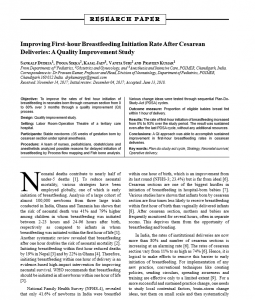
Neonatal deaths contribute to nearly half of under-5 deaths. To reduce neonatal mortality, various strategies have been employed globally, one of which is early initiation of breastfeeding. Analysis of a large cohort of almost 100,000 newborns from three large trials conducted in India, Ghana and Tanzania has shown that the risk of neonatal death was 41% and 79% higher among children in whom breastfeeding was initiated between 2-23 hours and 24-96 hours after birth, respectively as compared to infants in whom breastfeeding was initiated within the first hour of life. Another systematic review revealed that breastfeeding after one hour doubles the risk of neonatal mortality. Initiating breastfeeding within first hour reduced deaths by 19% in Nepal and by 22% in Ghana. Therefore, initiating breastfeeding within one hour of delivery is an evidence-based high-impact intervention for improving neonatal survival. WHO recommends that breastfeeding should be initiated in all newborns within one hour of life.
National Family Health Survey (NFHS-4), revealed that only 41.6% of newborns in India were breastfed within one hour of birth, which is an improvement from its last round (NFHS-3; 23.4%) but is far from ideal. Cesarean sections are one of the biggest hurdles in initiation of breastfeeding in hospital-born babies. Various studies have shown that infants born by cesarean section are four times less likely to receive breastfeeding within first hour of birth than vaginally delivered infants. After cesarean section, mothers and babies are frequently monitored for several hours, often in separate rooms. This deprives them from the opportunity of breastfeeding and bonding.
In India, the rates of institutional deliveries are now more than 80% and number of cesarean sections is increasing at an alarming rate. The rates of cesarean section vary from 11% to as high as 74%. Hence, it is logical to make efforts to remove this barrier to early initiation of breastfeeding. For implementation of any new practice, conventional techniques like creating policies, sending circulars, spreading awareness and training are effective only to a limited extent. For a more successful and sustained practice change, one needs to study local contextual factors, brain-storm change ideas, test them on small scale and then systematically expand, with simultaneous monitoring of processes and outcomes. With this premise, we planned a quality improvement process involving a series of Plan-DoStudy-Act (PDSA) cycles to improve the rates of first hour initiation of breastfeeding in babies born through cesarean section.
—
This special issue of Indian Pediatrics (September 2018; Volume 55: Number 9) highlights mechanisms that can support health care providers in using various quality improvement (QI) approaches and showcases some of the improvement projects undertaken in India by different teams.
The USAID ASSIST Project started working in India in September 2013; initially working directly with districts and facilities to help them learn how to use QI approaches to save lives. This work went well and the staff in these facilities were able to reduce perinatal mortality by 15% over 18 months. During this time, we met great partners from important organizations and institutions across India.
These institutions are now leading a growing movement to help more people apply QI methods to deliver care that prevents harm, improves outcomes, and meets the needs of the people receiving it through their own networks using domestic funding; continuing these lifesaving efforts after ASSIST technical support has ended.
The supplement shows important results of the ongoing QI work in these networks and shows how domestic QI networks, earlier supported by ASSIST, are now independently supporting and spreading the use of QI methods to provide better care.